Diving for Delicacies and Dollars
The Celebrated Past, Stagnant Present, and Possible Future of San Miguel Island's Abalone
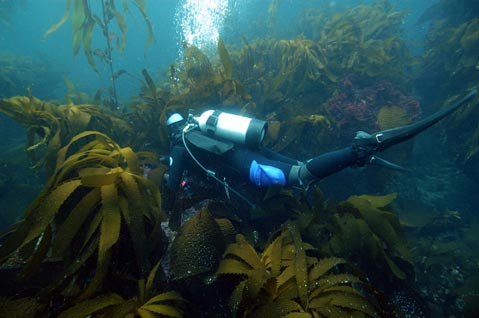
For California’s abalone divers, it was the best of times, fueled by a resource with seemingly no end. A community of pals and partners, the divers had the sea to themselves and all the abs they could grab. The daily limit in the 1970s was 20 dozen black abalones per permit, per landing-a bit less for the reds, pinks, greens, and whites-and a seafloor virtually paved with the big sea snails provided some 300 commercial divers in Southern and Central California with a fast-paced livelihood of sun, salt, wind, and wealth. Fifty-six-year-old Jim Marshall, an urchin diver from Carpinteria, still recalls the old days of this illustrious industry with a shred of nostalgia for something that may never return to its former state of abundance, for California’s abalones have suffered a fishery collapse as dramatic as they come. While some snails still crawl over the seafloor at San Miguel Island, gone are the divers.
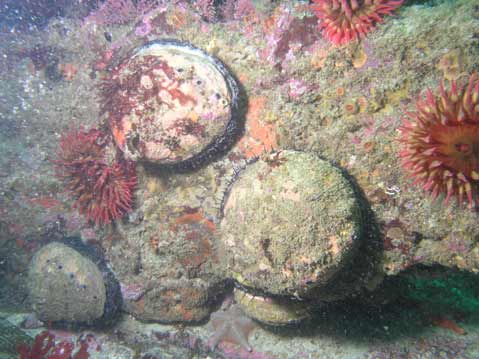
Gone, too, is the culinary culture of abalone once so integral to much of coastal California, and though the last hot aromas of fried, breaded, hand-caught abalone long ago vanished from the air, it lingers clear as day in the memories of those who were there. Scott Westlotorn grew up in Lompoc and remembers the communal abalone barbecues after a morning’s ab-grabbing at Hollister Ranch, where one could go at low tide and kick them from the rocks at a limit of 10 per day.
“We’d set up an assembly line of people,” Westlotorn, 58, reminisced, “and one would shuck them, another would slice them, the next person pound them, and finally we’d fry them. We ate so much abalone. We could eat all we wanted. People loved it, both as a food and as a social occasion, and no one thought it would ever end.”
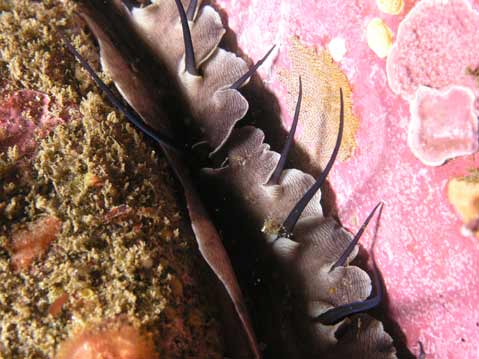
For commercial divers, the money was just half the point. Divers could make $150-$200 per day-not too shabby by today’s standards but a virtual fortune 30 years ago. After several years of deckhand work while a high schooler, Carpinteria’s Marshall plunged into this lucrative trade at the age of 19. In one particularly profitable month at the start of his career in the early ’70s, the young diver earned more than $1,800.
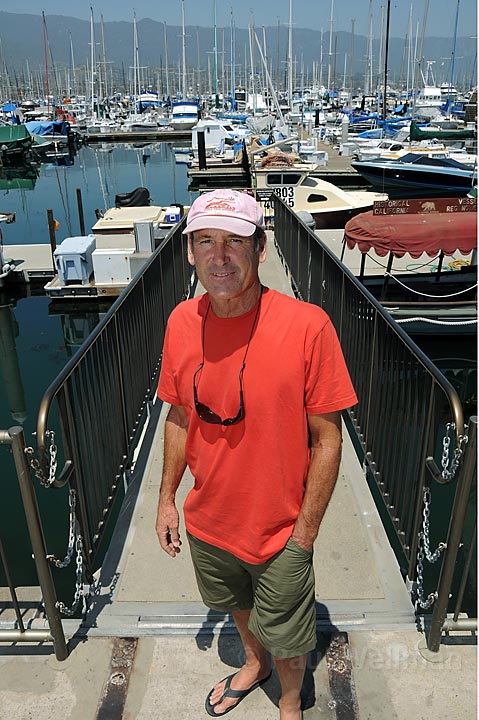
But it was the liberal lifestyle that made abalone diving a worthy pursuit, and for divers in the 1950s, ’60s, and early ’70s, the future was wide open. Laws and regulations were still few and a life on the ocean was a life of one’s own, with divers essentially determining their own seemingly boundless salaries. The per-landing limit allowed the option of making two or more landings per day, time permitting, and the Department of Fish and Game (DFG) enforced no annual limit.
Best of all, there was no hurry. Marshall and his deckhand sometimes stayed at the islands overnight while stockpiling hundreds of abalones on the deck, in the shade and under wet burlap, or kept fresh in live-wells. Marshall and others dived with hookah gear, and a diesel-powered engine pumped air through a hose down to the divers, who pried the abalones off the rocks with two-foot bars.
Back at the dock in Santa Barbara, the snails were unloaded and Marshall, who owned his own vessel most of his career, would make another run to the islands the next day or maybe the next week-he had no boss, the world was his oyster, and a pearl of a world it was, with the underwater realm fated to remain his office and playground for decades.
But as surely as hungry buyers met the boats in the harbor, the abalone beds began to thin out. Looking past a potential problem was easy at first, admits Marshall, who explained, “We’d just say, ‘Well, I guess they all moved to another spot.'”
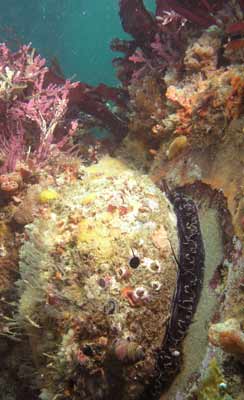
So the divers would also migrate to fresh abalone beds. In those days, all of the Channel Islands and most of Southern California were game for commercial harvest, so moving was easy. Yet the fishers couldn’t ignore the ominous feeling that this resource-along with their lucrative livelihood and free-wheeling lifestyle-was beginning to fade.
“I think people anywhere can always visualize in their minds that things won’t always be the same,” Marshall reflected recently. “Thing is, people also tend to ignore things that are staring them in the face.”
There was no ignoring it by the 1980s, when the fishery accelerated into a landslide collapse. The state’s DFG acted quickly in the 1990s, banning black abalone harvest in 1993. In 1996, white, green, and pink abalone were put under protection, and the following year, drastic legislation ended the harvest of red abalone south of Marin County. With that, a way of life came to an end and, in the remaining abalone beds, all went quiet.
But among circles of former ab divers-including many commercial urchin harvesters like Marshall, who switched to the spiky echinoderms when the snail hunt shut down-talk is growing louder about the possibility of reinstating an abalone fishery at San Miguel Island, the wind-blown and westernmost of the Channel Islands located just south of Point Conception and about a five-hour boat ride from Santa Barbara. The idea, in fact, is even being seriously considered by the DFG, but, as with all discussions of harvesting an imperiled species, opposition is strong. All parties do agree, however, that a new future in the abalone industry means understanding its failed past.
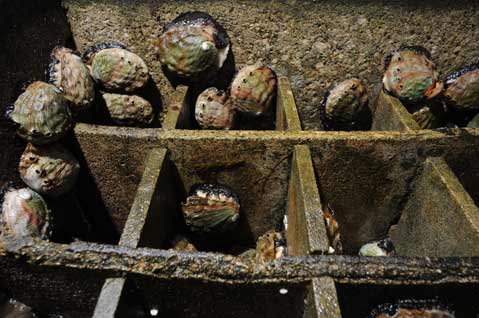
The Vanishing Snail
Debate still goes on as to why the abalones vanished. Some blame the DFG’s lack of management. In some regions, particularly the Central Coast, sea otters were clearly the culprit. Recreational divers also took a small but steady toll. But below Point Conception in Southern California, the blame is mostly shared by poachers, legal divers, and withering foot syndrome.
Caused by mysterious bacteria that are apparently harmless in cold water, withering foot takes effect during warm water regimes, like El Ni±o, when it interrupts the digestive processes of abalone and leads to malnourishment. That causes the infected snail’s foot to weaken and wither, and eventually the animal slips from the rock and cartwheels to the seafloor. Unable to reattach, the abalone become fast prey for an ocean’s worth of predators, or else they starve.
“When the abs started falling off the rocks at 10 percent attrition per year, we thought, ‘Oh my God, what’s going on?'” remembered Marshall. On the bottom, he and other divers began encountering upside-down abalones-mostly blacks and greens-with increasing frequency, and empty shells accumulated in the kelp beds.
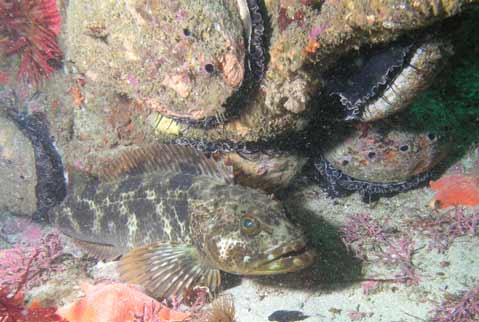
Westlotorn, who also graduated from a recreational picker into a professional diver by age 20, believes the disappearance of abalone was not due so much to withering foot, but to poaching. “Poaching killed the industry,” he explained. “It wasn’t withering foot, it wasn’t recreational diving. The divers didn’t want to believe it. They were in denial because the poachers were also their customers in some cases. If everyone believed that poaching was a problem, they would have closed the market.” He remembered often seeing shell piles on the ocean floor, indicators of at-sea processing of poached abalones that the DFG asked legal divers to report. “But they kept their mouths shut because they knew the DFG would close the season,” Westlotorn explained.
Whatever the true cause, the abalones vanished, and rather suddenly for a marine environment that once spilled over with the animals. The last days of low-tide rock-picking came in the late ’70s, and then the islands began to dry out. Near-shore locales went first, from the tide pools down, and San Miguel Island eventually remained as the last stronghold of red abalone south of the Golden Gate Bridge. By 1985, the entire fishery-which had topped three million annual pounds when it began 30 years prior-was only bringing in 200,000-300,000 pounds each year. Of that, about 120,000 pounds came straight from San Miguel.
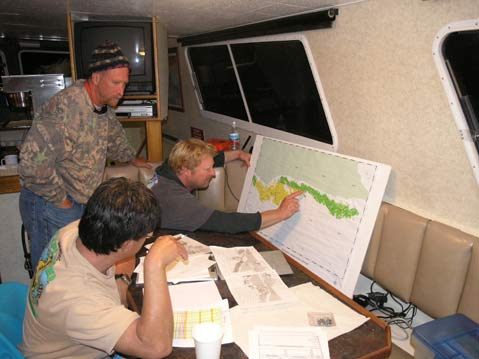
Return of the Abs?
Change comes very slowly for these sluggish mollusks, and among research, recreational, and commercial divers, there is no consensus whether red abalone numbers have grown, declined, or stayed steady at San Miguel Island since the last legal ab was plucked 11 years ago. Yet the very legislation that shut down the fishery mandated that the DFG develop a recovery plan and consider one day resuming the harvest. In December 2005, the Abalone Recovery and Management Plan (ARMP) went into effect and, today, motions are underway to potentially revive San Miguel’s fishery.
In 2006, the DFG appointed 12 individuals from recreational, commercial, and scientific backgrounds to the Abalone Advisory Group (AAG). With other experts, the group is considering such harvesting standards as total allowable catch, proper allocation to sport and commercial divers, and methods of monitoring the population. These discussions assume that the fishery will someday reopen-but that may never happen. The commercial divers on the AAG say they’ll foster innovative means of management, self-regulate their catch, and carefully watch the resource.
“We have the incentive to learn and do this right and preserve the fishery,” said Marshall, who is among the approximately 100 divers advocating a resumption of the fishery. “We’re trying to build a future here.”
But Milo Vukovich, president of the Sonoma County Abalone Network, a coalition of conservation-minded recreational divers, doesn’t believe the divers will responsibly manage the fishery. “We all saw that commercial divers didn’t protect the resource when they had it, so why would they do it now?” he asked. “Nothing’s even changed out there in 10 years because abalones grow so slowly.”
One benchmark for guiding this discussion is the state of the abalone population on California’s northern coast. This remote region hosts an unmatched abundance of large red abalones, which blanket the near-shore bottom from Sonoma County to Oregon. Recreational diving for the animals is still legal here, and by most accounts the population is well-managed and healthy, in spite of out-of-control poaching.
The DFG has conducted numerous surveys in recent years and found red abalone in excess of 7,000 and 8,000 per hectare, or 10,000 square meters. Density is critical because abalones are “broadcast spawners,” meaning that individuals release clouds of sperm and eggs to drift freely in the water column. If a male and female are not within a yard of one another, their spawn will likely dissipate without a single gamete fertilized. The hectare counts have been plugged into the ARMP to produce two figures of significance: the “minimum viable population” density of 2,000 abalones per hectare and the “minimum sustainable fishery” density of 6,600 per hectare. These numbers have been tentatively set as goals for the San Miguel Island population.
But survey dives in the summers of 2006 and 2007 found an average density of just 1,200 red abalones per hectare at the island. By these numbers, the discussion about a rebirth of the fishery should screech to an immediate halt, because according to the ARMP’s estimated “minimum viable population,” San Miguel Island’s red abalones are barely clinging to existence.
Marshall argues otherwise. He says that some San Miguel abalone beds are as dense as the northern coast’s, explaining that large swaths of barren seafloor not historically known to bear abalones negatively skewed the count. The important thing to consider, he says, is how close each abalone is to its neighbor, since that ultimately determines a population’s fertility. The two DFG surveys measured this parameter, and 85 percent of the counted abalones reside within one meter of each other. Chris Voss, 47, a former abalone diver and current president of the California Abalone Association, agrees with Marshall and goes one step further in suggesting that the northern coast’s big density counts were skewed in the other direction. “On their north coast surveys,” he explained, “they literally chose high density areas for their transects.”
Not so, according to DFG senior biologist Ian Taniguchi. He explained that most of the bottom habitat surveyed by divers at San Miguel Island was rocky and kelp-bearing -potential abalone habitat-and because of that the assessment was fairly valid. Another dive scheduled for early fall will add to the collection of information.
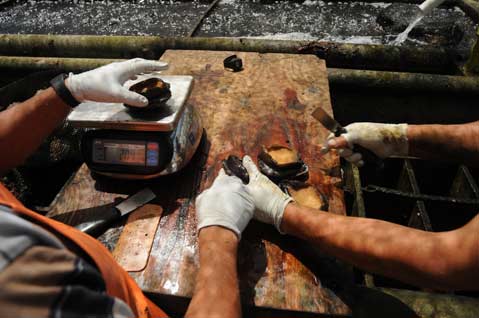
Abalone’s Allure
It may seem strange that a tough, rubbery, relatively flavorless flesh once attracted many vessels daily and still mobilizes some 40,000 sport divers every year on the northern coast. But abalone is delicious if properly tenderized. Pounding thin slices of the meat is the most common softening technique, though other means are effective. Some divers recommend carefully avoiding injuring the animals when prying them from the rocks. Gently handled before finally going into the freezer, such specimens die peaceful deaths. Their muscles relax, and when defrosted, these snails may be floppy-soft. Pressure-cooking a whole abalone foot for an hour also results in a tender hunk of meat and precludes any need to pound it.
The most popular abalone recipe consists of coating sliced and pounded abalone in bread crumbs, then quickly frying the pieces in oil. Other chefs wrap the foot in a towel, pound it until pulpy, enclose the two-pound glob in foil, and grill it. Others make sashimi and ceviche. Marshall, who occasionally travels north to dive for abalone in Sonoma County, enjoys fried abalone sandwiches.
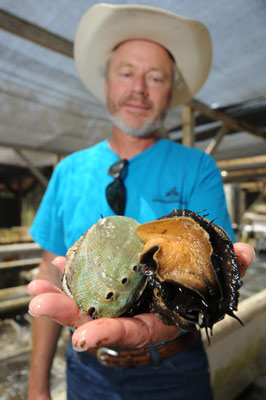
Aquaculture currently feeds the appetite for abalone in Southern California. The DFG established one of the first farms for research purposes in the 1970s at their Granite Canyon Marine Lab near Carmel, but various operations have come and gone through the years; today, a half-dozen large farms in California-most of them south of Half Moon Bay-sell hundreds of thousands of pounds of abalone per year at a value of almost $10 million. Most of the catch goes to high-end restaurants and foreign markets. The farms are all either on the water or adjacent to it and are considered highly sustainable facilities. They pump thousands of gallons of seawater per minute through a procession of open-topped cement tanks. Here the snails cling to the walls and munch fresh fronds of giant kelp, clipped from nearby beds.
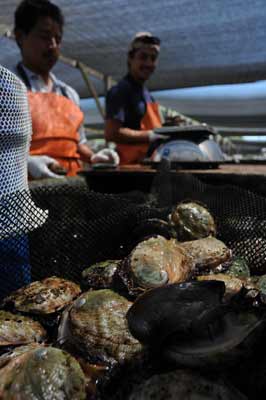
The Abalone Farm in Cayucos is the state’s largest farm, selling one million red abs per year to distributors, restaurants, and individuals. The “crop” is harvested at four to five years of age, when the snails have reached a live weight of approximately four ounces each and are just under four inches across the shell. Five dollars each wholesale, a single abalone of this size bears about one-and-a-half ounces of meat. By comparison, the foot alone of an average eight-inch, 15-year-old red abalone weighs approximately two pounds, and the largest recorded red ab foot weighed more than six pounds.
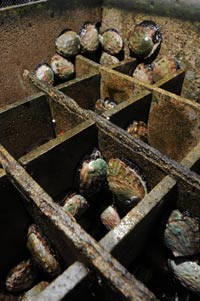
Brad Buckley, sales and marketing director at the Abalone Farm, hopes the San Miguel fishery may resume, as a market surge would likely follow. Westlotorn, who now works with the Abalone Farm developing products like packaged abalone steaks and dried abalone for the Asian market, also believes an experimental fishery could be a positive industry. A wild supply, he said, would mean less of a carbon impact than that of relatively energy-intensive abalone farms, though these onshore operations preclude the need for boat fuel. Like them or not, farms-such as the Cultured Abalone in Santa Barbara, one of the largest abalone farms in the state and the supplier of restaurants and distributors throughout the U.S., Canada, and Japan-will almost certainly provide the state with more abalones than a wild fishery ever will, and for now farmed silver dollar-sized ab feet are all we’ve got.
Practical Possibility or Pipe Dream?
There is no certainty that the Fish and Game Commission, the DFG’s governing body, will reopen a legal season on San Miguel reds, yet the AAG continues to prepare alternate harvest plans. Jessie Altstatt, 41, science director for Santa Barbara Channelkeeper and a member of the AAG, has spearheaded the ongoing design of a very unusual plan by which commercial and recreational divers would be employed through state and private funding to carefully pry abalones from the rocks and then transfer the snails alive to unpopulated nearby regions in an attempt to reestablish vanished stocks. Attentive monitoring would meanwhile determine whether the fished population could bear the limited harvest and whether the transplanted populations take root.
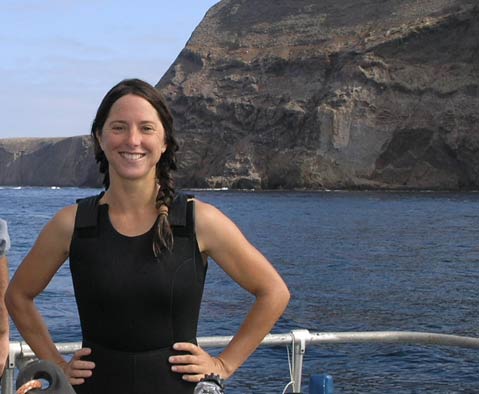
“I think testing the total allowable catch model before opening up the consumptive fishery is the most prudent and cautious approach there could be,” said Altstatt, who has participated in research dives at San Miguel and been slightly perturbed by the lack of small abalone-although she says many were likely out of sight in cracks and crevices, which is standard protocol for the one- to three-inchers. “But if there had been good recruitment anytime after the fishery closed,” she continued, “you’d think there would be more abalones moving up through a smaller size class. About the smallest abalone I measured was six inches.” Most, she explained, were larger than seven inches across the shell. “In a population where you’re going to be harvesting,” said Alstatt, “I think you want there to be more smaller ones than big ones so that you’ll still have a resource the next day.”
In spite of her skepticism, Altstatt is excited about the collaborative efforts between sport, commercial, and scientific divers. Other harvest proposals have been brought to the AAG roundtable for consideration. One suggested that divers only target isolated individuals not part of a viable breeding scheme. AAG member Terry Maas, an oral surgeon who has dived recreationally in Southern California for 35 years, proposed an equal division of the catch between commercial, recreational, and conservationist divers. There has also been discussion of allotting as much as 90 percent of the catch to commercial divers, much like the old days.
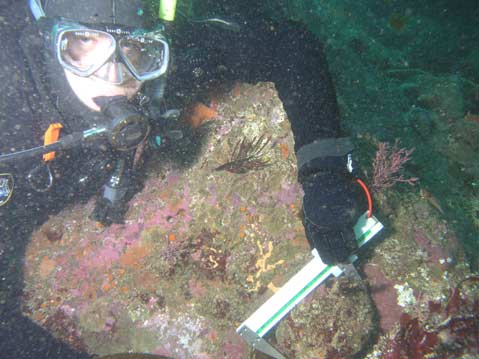
Voss, of the California Abalone Association, would like to see a system of self-management govern the fishery. Only divers who had permits before the closure would be legalized, and then they would bear responsibility for safeguarding the abalone population from abuse. Voss assures that the future industry would be different than the past and says that much of the recreational diving community has expressed unjust opposition to reopening the fishery. “This has gotten characterized and misrepresented as a group of commercial fishermen trying to attack the last remaining island of abalone,” he said.
Yet San Miguel Island’s colony of abalone truly is an isolated remnant of a once-tremendous resource. Even Northern California’s red abalone population of today comprises a small portion of what it once was, as an estimated 86 percent of the state’s historical red abalones once lived south of the Golden Gate Bridge. Humans cannot be blamed for the entire collapse, though.

Sea otters are documented devourers of abalone. Since being nearly exterminated 200 years ago by fur hunters, the predators’ numbers have steadily climbed. In regions where otters thrive today-primarily the coast near Big Sur-abalones live quiet, cryptic lives deep in crevices. Any that venture into open water are likely to become a quick meal. A report from the Central Coast in 1994 showed that within six years of sea otters’ reappearance near San Simeon, red abalone numbers crashed by 84 percent before stabilizing at 7 percent of the estimated 1965 population. The DFG’s Taniguchi said the red abalone abundance on the northern coast, void of sea otters, is an artificial situation.
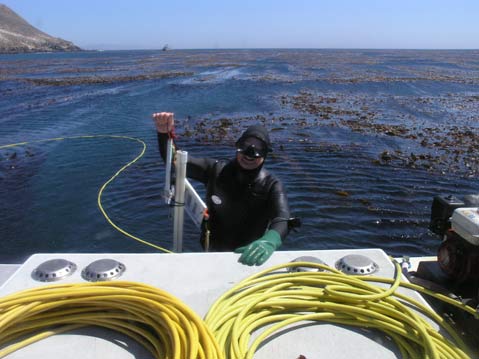
South of Point Conception, the enemies of abs consist primarily of withering foot syndrome and divers-who also happen to be among the snails’ best friends. These people understand the danger presented by withering foot, which has been found to remain dormant in more than 50 percent of the San Miguel red abalone population; in the event of another warm-water regime, withering foot could re-activate. Thus, the AAG has internally agreed that any fishery management plan must be adaptive. Should an emergency arise, the science and enforcement powers must be immediately available to assess the situation and adjust the harvest plan accordingly-even on a day’s notice.
The continued conversation depends on the ongoing analysis of available data. Are the abalones at San Miguel growing in numbers? If so, can they endure limited take? And to what extent? Experts from both sides of the picket lines are on the case, and the ultimate yea or nay will come from the California Fish and Game Commission-and it may not come for years.
For Marshall, Westlotorn, Voss, and others who have revered and eaten these big snails for much of their lives, the good ole days of grabbing, shucking, pounding, and frying dwell more than two decades in the past. There is no more bounty like there once was, and if a deep low tide ever exposes thick beds of legal-sized abs, it won’t be in our lifetimes. Yet a whole new era could be waiting, just over the horizon, some 50 miles to the west and 20 feet under.



